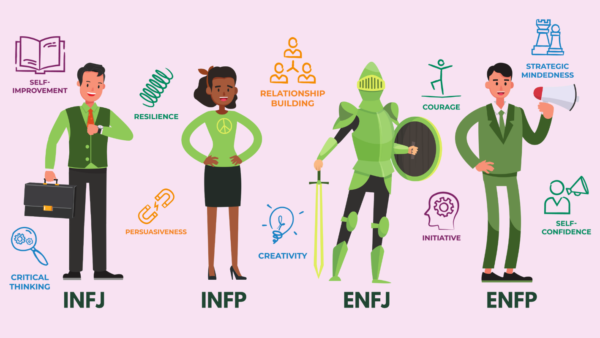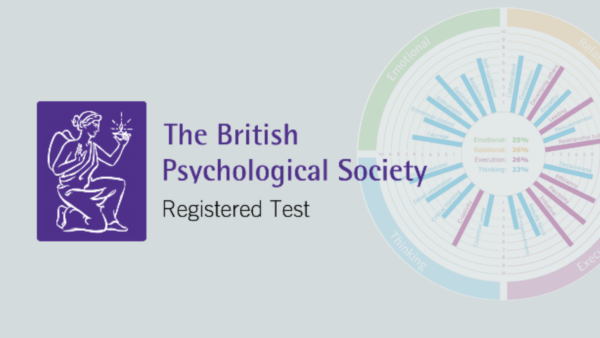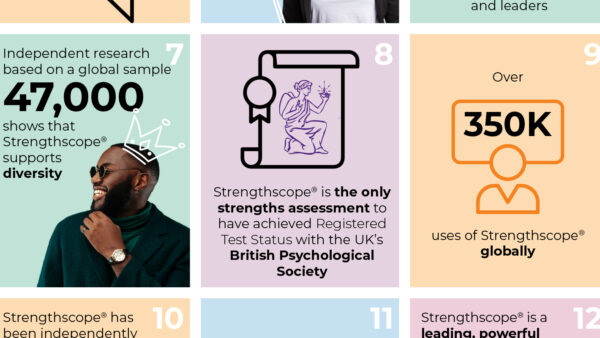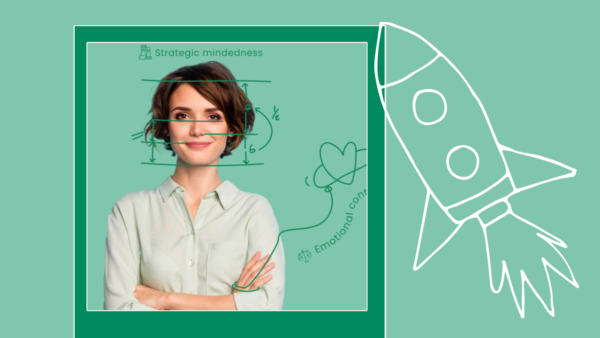The strengths-based approach offers a compliment and an antidote to the deficit approach. And strengths-based learning and development helps us focus on developing and stretching our strengths, rather than spending all of our time on hammering out our weaknesses and shortcomings.
Defining strengths-based learning and development and how it differs from the deficit approach
From birth, we are wading through a sea of negativity. Straight out of the womb, we are surrounded by guidance and diktats on how we should and shouldn’t behave, based on others’ strongly held beliefs about what is wrong and what is right.
Research also tells us that we are neurologically disposed towards focusing on risk and danger far more than we are towards positive stimuli. That combination gives us a perfect recipe for a negative internal dialogue to develop from early age. This ‘inner critic’ that lives in all of us will be telling us that we need to do better, to be stronger, quicker, smarter, more, different. Ultimately our inner critic tells us that we are not adequate, we are not enough.
And all this means that when we stumble across something in us that IS positive – a quality, skill, trait or talent, something that we naturally find easy or that we are good at, oftentimes we won’t see it at all, because we’re so focused on avoiding the bad stuff, working on it, improving it or running away or hiding from it. So we miss the positive, or we reduce its importance. Our inner critic is always there to remind us to focus on the far more important matter of what’s not good enough.
And so at school, at home and in our working lives, most of us significantly underbake the opportunity to work on what we’re naturally good at – our strengths – to turn them from good to outstanding, to go from competence to mastery. All because of that inherent human negativity bias combined with external negative feedback. Bring on the strengths-based approach and in particular, strengths-based learning and development.
Strengths-based learning and development has resonance in all aspects of our lives – school and education, home and work. It represents a re-balance towards focusing on the positive and to getting better in areas of natural strength for us. This blog is about strengths-based learning and development, why it matters and how to focus more of our time on it.
What does the research tell us about strengths-based learning and development?
If you’ve never seen it, Sir Ken Robinson’s TED talk ‘Do schools kill creativity’ is a must-see for me (https://www.ted.com/talks/sir_ken_robinson_do_schools_kill_creativity?language=en). In it, educationalist Sir Ken puts forward an argument that there is a hierarchy of school subjects – from Maths and Science at the top of the ‘best to do’ list to Arts at the bottom. And that this sets kids on a course from an early age to potentially diminish what they are naturally good at, or that they enjoy, in pursuit of study and qualifications that may bring them no joy or value in later life.
Sir Ken argues for parity in all subjects at school, to see each one as having its own value. And by that logic, to see each child’s natural talents and strengths as having value too, rather than pushing certain talents and strengths just because the education system places a premium on them.
In a similar vein, Howard Gardner put forward a theory of multiple intelligences in the 1980s that has become more mainstream in the thinking of many teachers, even if it hasn’t been widely adopted amongst politicians and policy-makers.
While Gardner’s theory has its critics, the principle that we all have different strengths and talents and that none should be seen as superior than others is a strong one. Gardner put forward the following intelligences in his theory: musical, visual-spatial, linguistic, logical-mathematical, kinaesthetic, interpersonal and intrapersonal. He later added naturalistic and existential intelligence to the list.
The idea originally was to encourage a move away from the very narrow definition of ‘general’ intelligence as being the ‘true’ measure of intelligence and therefore of someone’s strengths, to a more inclusive, eclectic definition which better represents the diversity of human talent, where all intelligences can be equal. And that’s relevant again because it incorporates the idea that it is ok to focus on what people naturally do well when thinking about learning and in this case, education.
In an earlier podcast, I used the example of the Nebraska speed-reading study, which is very relevant here. So let me summarise. In this study, designed to test the best way to teach rapid reading (with a sample of 6000 students), there were two methods of speed-reading tested and to the disappointment of the researchers, there were no significant differences found between the methods.
However, when the researchers looked more closely at the data they had gathered, across both speed reading methods, they found that those students who could read fastest to start with improved more than others. Far far more. In fact, their performance went from an average of 300 to 2900 words per minute – an average gain of 870%! The students who naturally read more slowly made some gains too (typically up from an average of 90 to 150 words a minute, which is a 66% gain), but those gains were tiny by comparison to the students who started off with speed-reading as a strength.
The researchers came up with a new hypothesis: that the greatest gains in learning can be achieved through investing in what people do well naturally.
This is profound. And with all I’ve said so far, hopefully you can start to see the argument for focusing more on our natural areas of strength, starting at school, but also at work and in life, if we want to achieve exceptional performance levels by developing in areas of strength. And if we want to get more energy and joy from learning.
Finding and developing your strengths – what you need to know
So how do you find your strengths and how do you turn them from good to great in a practical way? This is a fair question, given that so much of our developmental and learning focus is placed on dealing with the stuff we believe we’re NOT good at, to the detriment of strengthening our strengths. My advice is to start with an objective assessment of your strengths from a trusted source that works.
There are several strength assessments out there but all are not equal. Look for the British Psychological Society’s test registration status to be certain that you can trust the findings. That can easily be searched for here: https://ptc.bps.org.uk/test-registration-test-reviews/search-test-reviews
Once you’ve completed your strengths assessment, you might find yourself looking for some inspiration on how to stretch and develop your natural areas of strength in ways that will help you get more enjoyment from your job. Some assessments, Strengthscope included, handily give some tips on how you can take your strength to the next level in a work context but let me give you an example of a way of thinking about this.
And I need to provide a warning here – it’s not easy, initially at least, focusing on strength areas for development, because we are SO wired towards fixing weaknesses. So my advice is to stick with it and inspiration will come. Let’s take one of Strengthscope’s strengths – Courage – random choice. Defined as ‘taking on challenges and facing risks by standing up for what you believe in’. Here’s some ideas that can help you get more from it (these ideas are taken straight from the Strengthscope report BTW):
- Research effective influencing skills and practice these skills to ensure you can easily stand up for what you believe in ways that continue to promote healthy working relationships
- Seek out hot topic debates and innovation projects that you can contribute to that will help co-workers/stakeholders to look at problems and issues in a different way
- Go outside of your comfort zone by taking on a project that you really believe in that not only stretches your current skillset, but also your levels of confidence and self-belief.
So that’s the idea – find things that you can do in your current role and team, and/or with the support of others to get more from your strengths right now and to develop them further. And magically, you’ll find that you have more natural energy for doing the work to get there because your strengths are areas which energise you and which you’re already good at and have the potential to become exceptional at.
The vital role of growth mindset in strengths-based learning and development
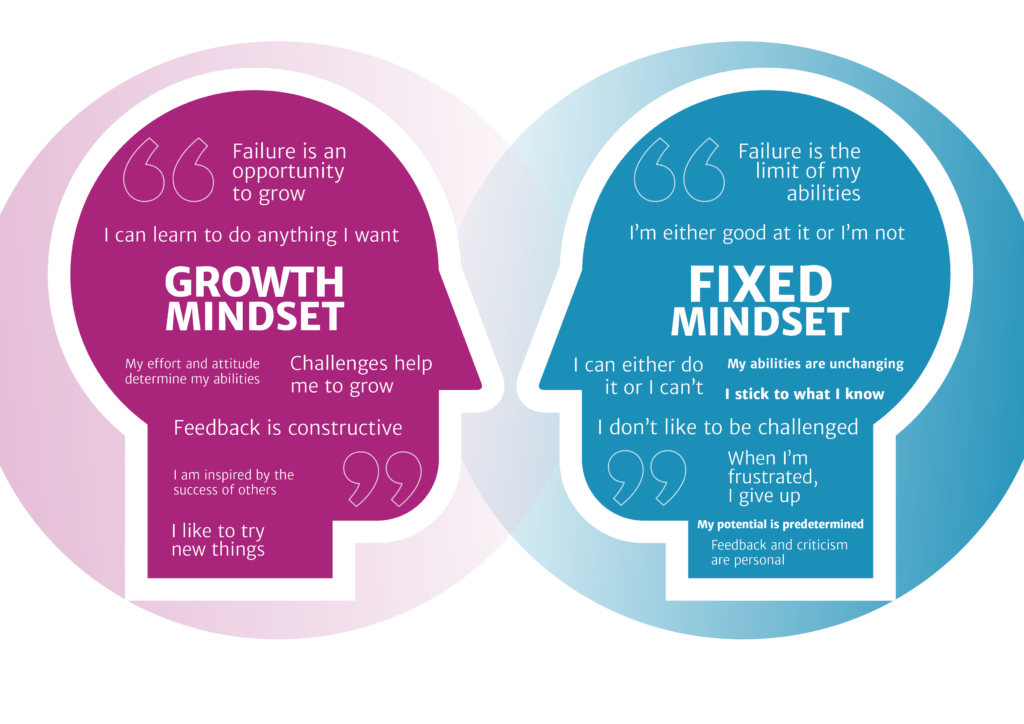
The final area I want to touch on today is growth mindset. Now my full podcast on growth mindset is THE most downloaded of all 172 episodes, so it might be worth you checking it out in full. If you want to, search for ‘What is growth mindset and how to develop one’ – it’s at Season 9, episode 11. Or go here: https://www.strengthscope.com/podcasts/how-to-develop-a-growth-mindset. In summary though, I want to mention growth mindset because it’s an important part of strengths-based learning and development.
What is growth mindset? To answer this, I need to explain the twin ideas of growth mindset and fixed mindset. Having a fixed mindset means that you generally believe that your abilities and your intelligence are fixed and can’t be changed and that you have had them since birth. Having a growth mindset means that you believe that the development of skills and abilities can evolve and change through persistence and hard work.
Why does this matter? Well, if you come from a place of fixed mindset, you might avoid challenges because you don’t want to feel embarrassed or humiliated in front of others. This can become an issue because your fear of making mistakes can lead you to avoid challenges and new experiences—experiences which could actually help you grow and develop.
If you have a growth mindset, you are more likely to enjoy challenges, despite the risk, usually because you value learning and growth more than you value any anxieties you may have about others thinking you don’t know what you’re doing. And because you’re willing to give new things a try, you often don’t know what you’re doing, at least not initially, but you don’t see that as a threat, more as an opportunity to learn and to get good at stuff that you might come to value.
With strengths-based learning and development, any fixed mindset fears and anxieties that you might have can be magnified because you’re stepping into a space where you’re owning that you actually have strengths and that you’re choosing to work on them in order to become even better in those areas. Fixed mindsetters’ inner critic voices might now be saying ‘well you’re setting yourself up for a fall here, aren’t you?’, ‘don’t want to look bigheaded or arrogant do you by saying you’ve got all these strengths, best to keep playing small’, etc, etc.
So you need to know that working on improving and developing your strengths can bring pain and anxiety before it starts to feel more normal. My advice? Stick with the discomfort, for there resides the greatest learning and opportunity. Said Yoda or someone. Or me, actually.
In conclusion – aim for strengths-based learning and development, because you’re worth it
Strengths-based learning and development is an opportunity to reset the balance away from deficits and weaknesses and towards stretching areas that naturally bring you energy, confidence and enjoyment. And it can take you from mediocre or ‘okay’ into areas where you’re pretty much untouchable. Find YOUR strengths and start stretching them because you’re worth it and that’s one way to bring your greatest gifts and talents to your job, your career and to the world.


